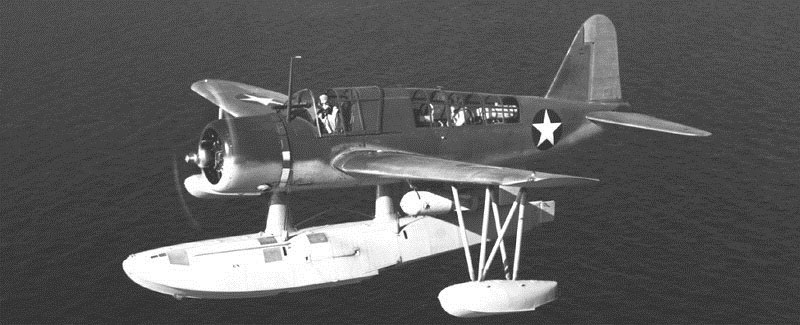
In 1937 The U.S. Navy issued specifications for a two seat Observation Scout floatplane with non-folding wings and the capability for a quick conversion to a land plane. Vought proposed the XOS2U-1 all metal monoplane as opposed to the biplanes currently in use. Spot welding construction was used providing a smooth, non-buckling fuselage skin. Weight was saved by covering the wings with fabric aft of the main spar. The aircraft featured full span flaps that hung from the trailing edge of the wing. Spoilers were also incorporated to supplement aileron control at low speeds. The aircraft was equipped with a Pratt & Whitney R-985-48 engine producing 450 HP. The small engine was selected in order to remain within weight requirements imposed by shipboard handling. The OS2U, however, could carry a respectable load. For antisubmarine work the aircraft carried two 325 pound depth charges, Two 100 pound bombs could be substituted if desired. A fixed .30 caliber machine gun was mounted in front of the pilot to fire forward and flexible .30 caliber mount was installed aft for the crewmember. The OS2U, named Kingfisher, was the U.S. Navy’s primary ship-based scout and observation airplane during World War II.
Vought delivered 54 OS2U-1s by November 1940. The OS2U-2 model was equipped with leak-proof fuel tanks, armor protection and a R-985-50 engine. The OS2U-3 was similar to the OS2U-2 but had increased fuel capacity. In September of 1942 production passed to the Naval aircraft Factory, with no basic changes, the aircraft designation became OS2N-1.
The Kingfisher could and did perform a variety of tasks. Beginning in March 1942 the Coast Guard received the first of 76 Kingfishers; 68 OS2U-3s, 7 OS2U-2s and 1 OS2N-1. Their primary purpose was to provide the Coast Guard’s early anti-submarine efforts along the coastlines of the United States. Area patrols were flown and air cover for merchant convoys was provided. They carried two 325 aerial depth charges and could fly patrols of up to six hours. None of the OS2Us were credited with sinking a submarine but they did make a number of attacks on submarines along the seaboards. There were 61 recorded attacks on enemy submarines made by Coast Guard aircraft. The preponderance of these was made in 1942 when there was a heavy concentration of German submarines off the Atlantic and Gulf coasts. They also made and coordinated many rescues of survivors from torpedoed ships.
The Kingfishers were discontinued from Coast Guard service by October, 1944
| Designation | OS2U-3 and OS2N-1 |
| Manufacturer | The OS2U-3 was manufactured by Vought –Sikorsky Division, United Aircraft. The OSN-1 was manufactured by the Naval Aircraft Factory. |
| Aircraft Type | Observation Scout – Seaplane — Used by the Coast Guard for ASW and rescue of personnel |
| Wing Span | 35’ 10” |
| Height | 15’ 1” |
| Length | 33’ 10” |
| Fuel Capacity | 144 gallons |
| Max Speed | 164 mph at 5,500 feet |
| Cruise Speed | 119 mph at 5,000 feet |
| Stall Speed | 50 mph |
| Initial Climb | 890 fpm |
| Range | 805 statute miles |
| Empty Weight | 4,123 lbs |
| Gross Weight | 6,000 lbs |
| Service Ceiling | 13,000 feet |
| Crew | 2 |
| Armament | The Coast Guard flew them with two 325 pound aerial depth charges attached |
| Power Plant | A 450 HP Pratt & Whitney R-985-AN-2/8 engine with a Hamilton Standard constant speed propeller |
